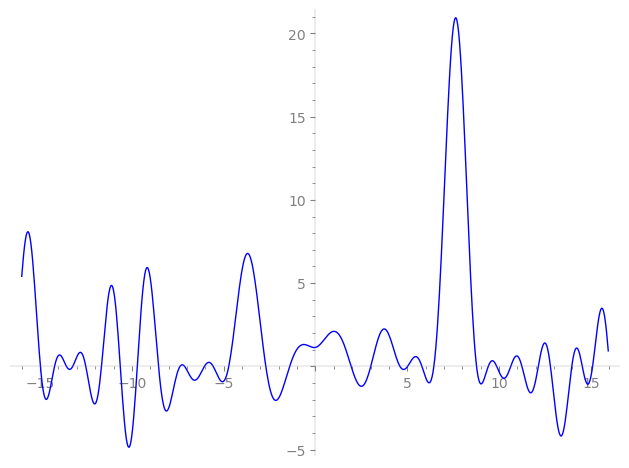| L(s) = 1 | + (0.5 + 0.866i)2-s + (−0.866 − 1.5i)3-s + (−0.499 + 0.866i)4-s + 1.73·5-s + (0.866 − 1.5i)6-s + (0.5 − 0.866i)7-s − 0.999·8-s + (−1 + 1.73i)9-s + (0.866 + 1.49i)10-s + 1.73·12-s + (−0.866 − 0.5i)13-s + 0.999·14-s + (−1.49 − 2.59i)15-s + (−0.5 − 0.866i)16-s − 2·18-s + ⋯ |
| L(s) = 1 | + (0.5 + 0.866i)2-s + (−0.866 − 1.5i)3-s + (−0.499 + 0.866i)4-s + 1.73·5-s + (0.866 − 1.5i)6-s + (0.5 − 0.866i)7-s − 0.999·8-s + (−1 + 1.73i)9-s + (0.866 + 1.49i)10-s + 1.73·12-s + (−0.866 − 0.5i)13-s + 0.999·14-s + (−1.49 − 2.59i)15-s + (−0.5 − 0.866i)16-s − 2·18-s + ⋯ |
Λ(s)=(=(728s/2ΓC(s)L(s)(0.967+0.252i)Λ(1−s)
Λ(s)=(=(728s/2ΓC(s)L(s)(0.967+0.252i)Λ(1−s)
| Degree: |
2 |
| Conductor: |
728
= 23⋅7⋅13
|
| Sign: |
0.967+0.252i
|
| Analytic conductor: |
0.363319 |
| Root analytic conductor: |
0.602759 |
| Motivic weight: |
0 |
| Rational: |
no |
| Arithmetic: |
yes |
| Character: |
χ728(237,⋅)
|
| Primitive: |
yes
|
| Self-dual: |
no
|
| Analytic rank: |
0
|
| Selberg data: |
(2, 728, ( :0), 0.967+0.252i)
|
Particular Values
| L(21) |
≈ |
1.135094935 |
| L(21) |
≈ |
1.135094935 |
| L(1) |
|
not available |
| L(1) |
|
not available |
L(s)=p∏Fp(p−s)−1 | p | Fp(T) |
|---|
| bad | 2 | 1+(−0.5−0.866i)T |
| 7 | 1+(−0.5+0.866i)T |
| 13 | 1+(0.866+0.5i)T |
| good | 3 | 1+(0.866+1.5i)T+(−0.5+0.866i)T2 |
| 5 | 1−1.73T+T2 |
| 11 | 1+(0.5−0.866i)T2 |
| 17 | 1+(0.5+0.866i)T2 |
| 19 | 1+(−0.5−0.866i)T2 |
| 23 | 1+(−0.5−0.866i)T+(−0.5+0.866i)T2 |
| 29 | 1+(0.5−0.866i)T2 |
| 31 | 1−T2 |
| 37 | 1+(0.5−0.866i)T2 |
| 41 | 1+(0.5−0.866i)T2 |
| 43 | 1+(0.5+0.866i)T2 |
| 47 | 1−T2 |
| 53 | 1−T2 |
| 59 | 1+(0.866−1.5i)T+(−0.5−0.866i)T2 |
| 61 | 1+(0.866−1.5i)T+(−0.5−0.866i)T2 |
| 67 | 1+(0.5−0.866i)T2 |
| 71 | 1+(0.5−0.866i)T+(−0.5−0.866i)T2 |
| 73 | 1−T2 |
| 79 | 1+2T+T2 |
| 83 | 1+T2 |
| 89 | 1+(0.5−0.866i)T2 |
| 97 | 1+(0.5+0.866i)T2 |
| show more | |
| show less | |
L(s)=p∏ j=1∏2(1−αj,pp−s)−1
Imaginary part of the first few zeros on the critical line
−10.63157422720753413224646223117, −9.704823732937147800103367237743, −8.548102689221723831599473891750, −7.37503432491491403919223077770, −7.13135071590034197549836871651, −6.04670808622422837535819918405, −5.57357652766491961380423211411, −4.72196742669697703902744266762, −2.70531240019805837894332022205, −1.40302546205491119264690240160,
1.94224099105061124587509288696, 3.01380030288860445188221829542, 4.59982418802210044406978793320, 5.02074188124954739642311961318, 5.79829003412315497443300531174, 6.44955491513201741717966213335, 8.774809372988672521730911430359, 9.414234912420366850561707505944, 9.871378168251772001822184329977, 10.63868279463485881251013491010

